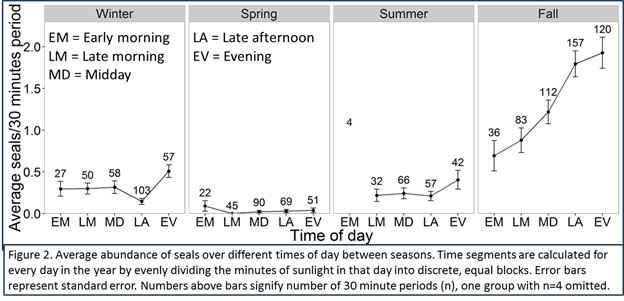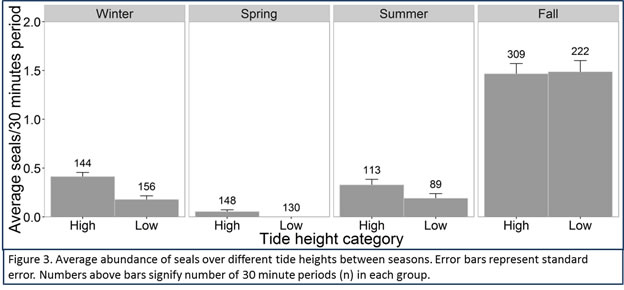June 2016
A look back on the 2015-2016 year: what did we learn?
Daniel Woodrich, undergraduate student
25 June 2016
Nine months have passed since I first began to manage the project. This was a good year for the lab: the project was awarded a grant of $150 by the WWU Research and Creative Opportunities for Undergraduates program, the poster I presented at the WWU Student Scholars Week was selected as an Outstanding Poster, and we took on several new members this spring that are set to be big contributors to the future of the project. Additionally, this project made strides in computer infrastructure with software I designed to help manage the project, such as the schedule maker script and a tool that enabled me to record hours for lab members.
All of these accomplishments help the project function and continue, however, of utmost importance is what we learned about our study system through our research.
Tide height class and time of day linked to harbor seal abundance at different times in the year.
Harbor seal abundance at the creek appears to be related to time of day and tide height, with the relative importance of each factor changing seasonally. More specifically, time of day is an important predictor of harbor seal abundance in the fall, but unimportant in the other seasons, while tide height (H or L) is an important predictor of harbor seal abundance in seasons other than fall.
This observation was supported graphically as well as numerically with GLMMs (Generalized linear mixed models). GLMMs are used to evaluate the relative importance of measurable factors in complicated systems. GLMMs are evaluated by comparing relative AIC scores, with the lowest score suggesting a more appropriate model, as well as parsimony (Bolker et al. 2009).


The correlation between harbor seal abundance and time of day in the fall could be related to the movements of the returning adult salmonids: a study on factors influencing the return of adult Atlantic salmon found that there were many more salmon returning nocturnally than in the day time[2] Greater prey availability at night could be related to this seasonal diel trend in seal abundance. Why tide height class may be less of a factor in the fall could be explained by a shift in priority towards hunting in the fall when returning adult salmon are present, and a behavior shift towards safety and avoiding humans in the other seasons by avoiding low tide in the estuary.
b) Fish abundance variables: they matter!
The best GLMMs for the entire dataset showed that all fish abundance count variables except for pink salmon helped explain the presence of seals in the creek (Woodrich and Aceevdo-Gutierrez 2016). Preliminary GLMMs splitting the data into even and odd years showed that pink and chum may be the important fish variable in odd years, whereas steelhead trout may be the only important fish variable for predicting harbor seal abundance in even years.
Data processing: necessary advances for future analysis
This year, the data was worked up in RStudio, and a couple important strides were made in data management that will be critical to retain for future analyses. The first is the creation of a script that gave unique IDs to each observation- previously, unique dates had been used as a proxy for unique observations, but there are many days in the record that have two separate observations. Another stride was the creation of a script that translated the time of each observation into a minutes counter, allowing for categorical comparisons of diel analysis (seen in figure 2 above as EM, LM, MD, LA, EV). Scripts that allowed for the integration of outside data on daylight time were also essential for this analysis. Scripts that allowed for the integration of tide data helped correct an unreliable data source (previously, tide height class (H/L) was entered by lab members at the creek, which could often be misleading due to “high low” or “low high tides”), ensuring this variable can be used in future analysis. Finally, scripts that enabled the removal of the “time 0” row in each observation from the dataset helped ensure that each data entry had the same assumptions, which is necessary for appropriately summarizing our data.
I am incredibly grateful to have had such meaningful research experiences as an undergraduate in Alejandro’s lab. I am so proud of my lab members and the work we have accomplished together, and am very excited to see where the new student leadership takes the project next. As for me, I am currently looking for work in the marine biology/ecology field, and hope to go to grad school to get back involved in research after gaining experience. For any prospective students thinking about a career in marine mammal research, I couldn’t recommend this lab enough.
References:
- Bolker, B. M., Brooks, M. E., Clark, C. J., Geange, S. W., Poulsen, J. R., Stevens, M. H. and White, J. S. (2009) Generalized linear mixed models: A practical guide for ecology and evolution. Trends in Ecology & Evolution 24: 127-135. doi:10.1016/j.tree.2008.10.008
- Smith, I. (1997) Tidal and diel timing of river entry by adult Atlantic salmon returning to the Aberdeenshire Dee, Scotland. Journal of Fish Biology 50: 463-474. doi:10.1006/jfbi.1996.0306
- Woodrich, D. and Acevedo-Gutierrez, A. (2016) Effects of environmental variables on harbor seal (Phoca vitulina) occurrence at a seasonal foraging site in Bellingham, Washington. Scholars' Week poster presentation, Wastern Washington University, Bellingham, WA